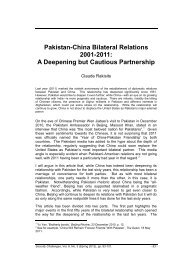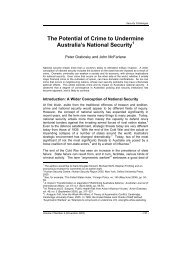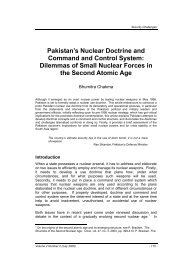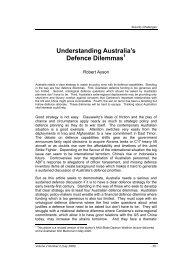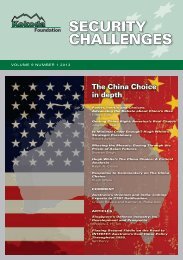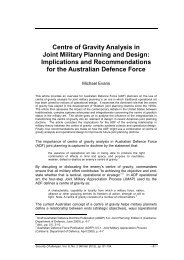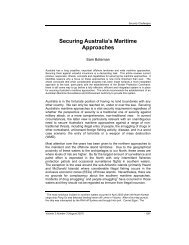The Transformation of Triad - Security Challenges
The Transformation of Triad - Security Challenges
The Transformation of Triad - Security Challenges
You also want an ePaper? Increase the reach of your titles
YUMPU automatically turns print PDFs into web optimized ePapers that Google loves.
Roderic Broadhurst and Lee King Wa<br />
and are the foundations <strong>of</strong> the discipline <strong>of</strong> the triad society. 130 <strong>The</strong><br />
complexity <strong>of</strong> the connections between triads and crime can be simplified by<br />
demystifying the cultural aspects that have tended to obscure their functional<br />
nature. Mak, 131 in a seminal study <strong>of</strong> Malaysian Chinese secret societies,<br />
noted that they were both cooperative and competitive groups functionally<br />
interdependent (‘symbiotic’) on other groups and institutions in the larger<br />
society. This underworld was characterised by competitive relationships that<br />
arose from conflicts over traditional inter-group grievances, ideological<br />
differences, and monopolisation. <strong>The</strong> inadequacy <strong>of</strong> legal norms in colonial<br />
society was the basis for the protective role—the ‘strong arm’ that ensured<br />
the persistence <strong>of</strong> criminal secret societies as quasi shadow states. 132<br />
Lee 133 drew on Mak 134 to describe the nexus between triad societies and<br />
their associated youth ‘gangs’ and crime networks. A dynamic form <strong>of</strong><br />
symbiosis between triad groups, criminal entrepreneurs and delinquent<br />
businesses, <strong>of</strong>ficials and pr<strong>of</strong>essionals was associated with triad-related<br />
lethal violence. <strong>The</strong> mutual-aid orientation <strong>of</strong> triad societies also engendered<br />
a competitive nature that served to link other criminal groups. <strong>Triad</strong> societies<br />
served a protective role (although this could slip to extortion and develop into<br />
criminal enterprise) in the command structure <strong>of</strong> criminal and, in some<br />
cases, non-criminal enterprises.<br />
In order to gain control over illicit opportunities, counter threats from other<br />
criminal groups or law enforcement, or to expand and develop the common<br />
interest, triad societies evolved simple command or corporate-like<br />
structures. 135 <strong>The</strong> leaders or specialists that hold power in the developing<br />
corporate structure <strong>of</strong> triad societies detached from the ordinary unskilled<br />
members and <strong>of</strong>fered their services in illicit markets. <strong>The</strong> symbiotic<br />
participation <strong>of</strong> triad societies in organised crime was thus facilitated by such<br />
individuals. <strong>The</strong>y played a strategic role in both the underworld and the<br />
larger society, forming the essential networks that aided illicit business. 136<br />
Mak called them ‘double-role players’ who were the most experienced triads<br />
with the skills, connections and abilities to contribute effectively to the<br />
particular organised crime activity. Pr<strong>of</strong>itable roles such as the ‘strong arm’<br />
130 Paoli, ‘<strong>The</strong> Paradoxes <strong>of</strong> Organized Crime’.<br />
131 Mak, <strong>The</strong> Sociology <strong>of</strong> Secret Societies.<br />
132 Hawley’s ecological theory <strong>of</strong> community integrated by Mak with Hobsbawm’s analysis <strong>of</strong><br />
banditry and business and the concept <strong>of</strong> anomie is retained here as a metaphor <strong>of</strong> the dynamic<br />
symbiosis among competing but sometimes cooperating triads: homeostasis would be rare. See<br />
A. H. Hawley, Human Ecology: A <strong>The</strong>ory <strong>of</strong> Community Structure (New York: Ronald Press,<br />
1950); E. J. Hobsbawm, Primitive Rebels: Studies in Archaic Forms <strong>of</strong> Social Movement in the<br />
19th and 20th Centuries (Manchester: Manchester University Press, 1959).<br />
133 Lee, ‘<strong>Triad</strong>-related Homicide 1989–1998’.<br />
134 Mak, <strong>The</strong> Sociology <strong>of</strong> Secret Societies.<br />
135<br />
Ibid.<br />
136<br />
See for a similar network perspective Milward and Raab, ‘Dark Networks as Organizational<br />
Problems: Elements <strong>of</strong> a <strong>The</strong>ory’.<br />
- 20 - <strong>Security</strong> <strong>Challenges</strong>



